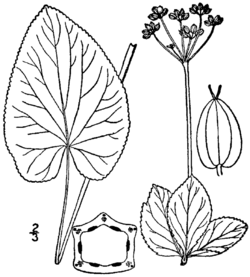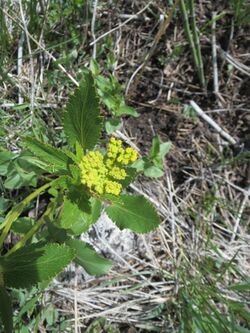Biology:Zizia aptera
| Zizia aptera | |
|---|---|

| |
| Botanical illustration | |

| |
| Zizia aptera in bud | |
| Scientific classification | |
| Kingdom: | Plantae |
| Clade: | Tracheophytes |
| Clade: | Angiosperms |
| Clade: | Eudicots |
| Clade: | Asterids |
| Order: | Apiales |
| Family: | Apiaceae |
| Genus: | Zizia |
| Species: | Z. aptera
|
| Binomial name | |
| Zizia aptera (A.Gray) Fernald (1939)
| |
| Synonyms | |
| |
Zizia aptera is a flowering plant native to North America. Its common names include meadow zizia, golden alexanders, heart leaved golden alexanders, and prairie golden alexanders.[1]
Description
The leaves are 2.5–10 centimetres (1–4 inches) long, ovate and indented at the base, with jagged edges; the upper leaves are divided into three segments.[2] Compound umbels of yellow flowers bloom atop the stems from May to July. The fruits are elliptical.[2]
Distribution and habitat
Zizia aptera can be found throughout southern Canada and much of the continental United States, though it is absent in the Southwest, the southern Great Plains, and New England.[3] It inhabits wet areas.[2]
Conservation
Zizia aptera is listed as endangered in Connecticut,[4] as rare in Indiana , as threatened in Michigan, and as "historical" (extirpated) in Rhode Island.[1]
References
- ↑ 1.0 1.1 "Plants Profile for Zizia aptera (Meadow zizia)". https://plants.usda.gov/core/profile?symbol=ziap.
- ↑ 2.0 2.1 2.2 Spellenberg, Richard (2001). National Audubon Society Field Guide to North American Wildflowers: Western Region (rev ed.). Knopf. pp. 342-343. ISBN 978-0-375-40233-3. https://archive.org/details/nationalaudubons00spel/page/342/.
- ↑ "Zizia aptera". Species. GBIF. http://www.gbif.org/species/3034518.
- ↑ "Connecticut's Endangered, Threatened and Special Concern Species 2015". State of Connecticut Department of Energy and Environmental Protection Bureau of Natural Resources. Retrieved 31 December 2017.(Note: This list is newer than the one used by plants.usda.gov and is more up-to-date.)
Wikidata ☰ Q15597413 entry
 |

